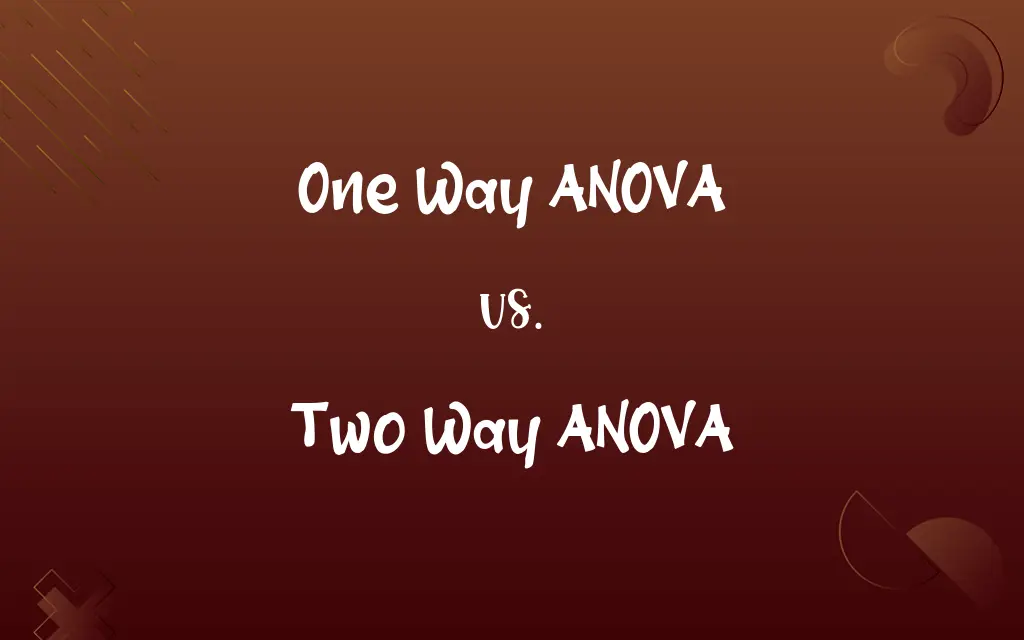One Way ANOVA vs. Two Way ANOVA: Know the Difference

By Shumaila Saeed || Published on January 25, 2024
One Way ANOVA tests the impact of a single factor on a single response variable, while Two Way ANOVA assesses the effects of two independent factors and their interaction on a response variable.

Key Differences
One Way ANOVA is used to analyze the impact of one independent variable (factor) on a dependent variable. It allows researchers to understand if there are statistically significant differences between the means of three or more unrelated groups. In contrast, Two Way ANOVA analyzes two independent variables simultaneously. It not only assesses the individual impact of each factor but also investigates if there is any interaction effect between the two factors on the dependent variable.
Shumaila Saeed
Jan 25, 2024
One Way ANOVA is simpler and is often used for basic experimental designs where the focus is on understanding the effect of a single variable. For instance, testing the effect of different diets on weight loss. Two Way ANOVA, being more complex, is suitable for experiments where researchers need to understand the combined effect of two variables, such as the impact of diet and exercise on weight loss.
Shumaila Saeed
Jan 25, 2024
In One Way ANOVA, the variability among the groups is compared to the variability within the groups for one factor. It primarily looks at one source of variance. On the other hand, Two Way ANOVA breaks down the variability into three parts: variability due to the first factor, the second factor, and the interaction between the two factors.
Shumaila Saeed
Jan 25, 2024
The interpretation of a One Way ANOVA focuses on whether there is a significant difference between the group means related to one factor. For Two Way ANOVA, the interpretation is more complex, as it involves understanding not only the main effects of each factor but also whether the interaction between these factors is significant.
Shumaila Saeed
Jan 25, 2024
One Way ANOVA requires data from different groups for a single factor, whereas Two Way ANOVA requires a more complex data set that includes information for two different factors. This makes the data collection and experimental design for Two Way ANOVA more intricate.
Shumaila Saeed
Jan 25, 2024
ADVERTISEMENT
Comparison Chart
Number of Factors
Analyzes one independent variable
Analyzes two independent variables
Shumaila Saeed
Jan 25, 2024
Complexity
Simpler, easier to conduct and interpret
More complex, provides richer information
Shumaila Saeed
Jan 25, 2024
Purpose
Tests the effect of one factor
Tests the effect of two factors and their interaction
Shumaila Saeed
Jan 25, 2024
Variance Analysis
Examines one source of variance
Examines three sources of variance
Shumaila Saeed
Jan 25, 2024
Data Requirements
Requires data for one factor
Requires data for two factors
Shumaila Saeed
Jan 25, 2024
ADVERTISEMENT
One Way ANOVA and Two Way ANOVA Definitions
One Way ANOVA
One Way ANOVA is a statistical method to test the equality of multiple means.
Using One Way ANOVA, they assessed the impact of four fertilizers on plant growth.
Shumaila Saeed
Jan 06, 2024
Two Way ANOVA
Two Way ANOVA evaluates the effect of two independent variables on a response.
Two Way ANOVA was used to study the effects of temperature and humidity on product durability.
Shumaila Saeed
Jan 06, 2024
One Way ANOVA
One Way ANOVA tests the null hypothesis that all group means are equal.
The One Way ANOVA disproved the hypothesis that all diets were equally effective.
Shumaila Saeed
Jan 06, 2024
Two Way ANOVA
Two Way ANOVA breaks down variance into three components: two main effects and their interaction.
Two Way ANOVA helped understand how age and gender independently and jointly affected buying habits.
Shumaila Saeed
Jan 06, 2024
One Way ANOVA
One Way ANOVA partitions total variance into between-group and within-group components.
One Way ANOVA showed the variance in test scores was due to teaching methods, not chance.
Shumaila Saeed
Jan 06, 2024
ADVERTISEMENT
Two Way ANOVA
Two Way ANOVA tests for interaction effects between two factors.
Using Two Way ANOVA, researchers found an interaction between diet and exercise on weight loss.
Shumaila Saeed
Jan 06, 2024
One Way ANOVA
One Way ANOVA compares the means of three or more independent groups.
One Way ANOVA revealed significant differences in customer satisfaction across three stores.
Shumaila Saeed
Jan 06, 2024
Two Way ANOVA
Two Way ANOVA tests multiple hypotheses about the effects of two variables.
Two Way ANOVA tested whether both temperature and pressure changes influenced chemical reaction rates.
Shumaila Saeed
Jan 06, 2024
One Way ANOVA
One Way ANOVA tests differences between groups under one factor.
The researcher used One Way ANOVA to analyze the effectiveness of different teaching methods.
Shumaila Saeed
Jan 06, 2024
Two Way ANOVA
Two Way ANOVA provides a more comprehensive model by including two factors.
The study used Two Way ANOVA to examine how dosage and patient age affected medication efficacy.
Shumaila Saeed
Jan 06, 2024
Repeatedly Asked Queries
Is One Way ANOVA suitable for two groups?
No, for two groups, a t-test is more appropriate.
Shumaila Saeed
Jan 25, 2024
What is One Way ANOVA used for?
It's used to compare means of three or more groups for one factor.
Shumaila Saeed
Jan 25, 2024
Can Two Way ANOVA assess interaction effects?
Yes, it can test for interaction effects between two factors.
Shumaila Saeed
Jan 25, 2024
Can Two Way ANOVA handle more than two factors?
No, for more than two factors, a Three Way ANOVA or other methods are used.
Shumaila Saeed
Jan 25, 2024
Are assumptions different for One Way and Two Way ANOVA?
They share similar assumptions like normality and homogeneity of variance.
Shumaila Saeed
Jan 25, 2024
What does an interaction effect in Two Way ANOVA indicate?
It indicates that the effect of one variable depends on the level of the other variable.
Shumaila Saeed
Jan 25, 2024
What type of data is needed for One Way ANOVA?
Quantitative data from three or more groups related to one factor.
Shumaila Saeed
Jan 25, 2024
How many hypotheses does One Way ANOVA test?
It tests one main hypothesis about the equality of group means.
Shumaila Saeed
Jan 25, 2024
How is variance analyzed in One Way ANOVA?
Variance is partitioned into between-group and within-group components.
Shumaila Saeed
Jan 25, 2024
Does One Way ANOVA require equal sample sizes?
Equal sizes are ideal, but it can handle unequal sizes with robustness.
Shumaila Saeed
Jan 25, 2024
What are the limitations of One Way ANOVA?
It can only analyze one factor and requires independent samples.
Shumaila Saeed
Jan 25, 2024
How does sample size affect Two Way ANOVA?
Larger sample sizes increase the power and accuracy of the test.
Shumaila Saeed
Jan 25, 2024
Can One Way ANOVA determine which groups differ?
No, post-hoc tests are needed for specific group comparisons.
Shumaila Saeed
Jan 25, 2024
Can One Way ANOVA handle repeated measures?
No, repeated measures require a different ANOVA type.
Shumaila Saeed
Jan 25, 2024
Are graphical methods useful with ANOVA?
Yes, boxplots and interaction plots can be informative.
Shumaila Saeed
Jan 25, 2024
What is the primary benefit of using Two Way ANOVA?
It allows for a more complex analysis involving two factors and their interaction.
Shumaila Saeed
Jan 25, 2024
What is a main effect in Two Way ANOVA?
The individual effect of each independent variable.
Shumaila Saeed
Jan 25, 2024
What kind of experimental design suits Two Way ANOVA?
Designs involving two independent variables.
Shumaila Saeed
Jan 25, 2024
Does Two Way ANOVA require balanced data?
Balanced data is ideal, but it can handle unbalanced designs with caution.
Shumaila Saeed
Jan 25, 2024
Can Two Way ANOVA be used for non-numeric data?
No, it requires numeric response data.
Shumaila Saeed
Jan 25, 2024
Share this page
Link for your blog / website
HTML
Link to share via messenger
About Author
Written by
Shumaila SaeedShumaila Saeed, an expert content creator with 6 years of experience, specializes in distilling complex topics into easily digestible comparisons, shining a light on the nuances that both inform and educate readers with clarity and accuracy.








































































